词汇学 名词解释(部分)
英语词汇学重点名词解释(2)
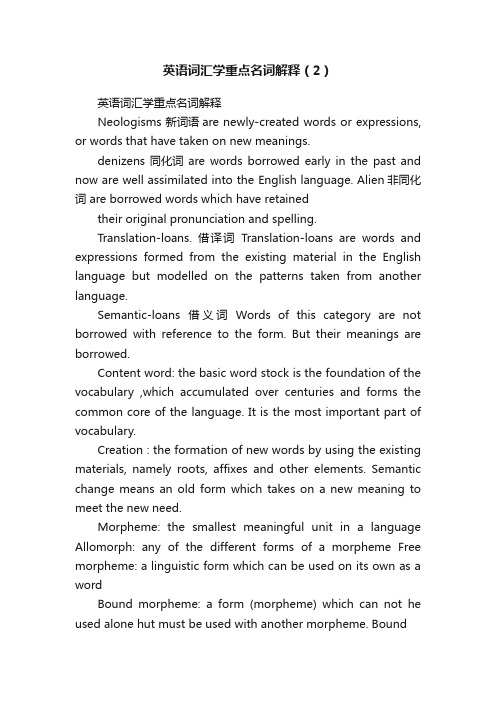
英语词汇学重点名词解释(2)英语词汇学重点名词解释Neologisms 新词语are newly-created words or expressions, or words that have taken on new meanings.denizens同化词are words borrowed early in the past and now are well assimilated into the English language. Alien非同化词 are borrowed words which have retainedtheir original pronunciation and spelling.Translation-loans. 借译词Translation-loans are words and expressions formed from the existing material in the English language but modelled on the patterns taken from another language.Semantic-loans借义词Words of this category are not borrowed with reference to the form. But their meanings are borrowed.Content word: the basic word stock is the foundation of the vocabulary ,which accumulated over centuries and forms the common core of the language. It is the most important part of vocabulary.Creation : the formation of new words by using the existing materials, namely roots, affixes and other elements. Semantic change means an old form which takes on a new meaning to meet the new need.Morpheme: the smallest meaningful unit in a language Allomorph: any of the different forms of a morpheme Free morpheme: a linguistic form which can be used on its own as a wordBound morpheme: a form (morpheme) which can not he used alone hut must be used with another morpheme. Boundmorphemes include hound roots and affixesAffixes: forms that are attached to words or word elements to modify meaning or functionPrefixation(suffixation): is the formation of new words by adding prefixes(suffixes) to stemInflectional affixes: affixes attached to the end of words to indicate grammatical relationshipsDerivational affixes: affixes added to other morphemes to create new wordsRoot: a morpheme which is the basic part of a word that can not be further analyzed without total loss of identity Stem: a form to which affixes of any kind can be added Bound root: a root that can not stand alone as a word Monomorphemic words: words that have nothing more than a free morpheme《英语词汇学重点名词解释》。
英语词汇学中的名词解释
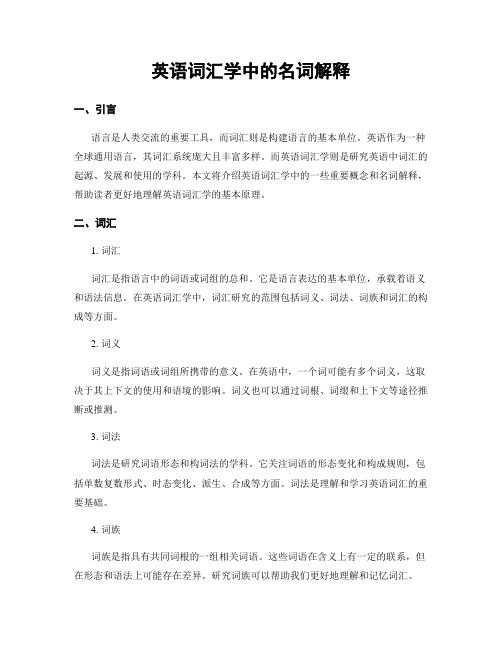
英语词汇学中的名词解释一、引言语言是人类交流的重要工具,而词汇则是构建语言的基本单位。
英语作为一种全球通用语言,其词汇系统庞大且丰富多样。
而英语词汇学则是研究英语中词汇的起源、发展和使用的学科。
本文将介绍英语词汇学中的一些重要概念和名词解释,帮助读者更好地理解英语词汇学的基本原理。
二、词汇1. 词汇词汇是指语言中的词语或词组的总和。
它是语言表达的基本单位,承载着语义和语法信息。
在英语词汇学中,词汇研究的范围包括词义、词法、词族和词汇的构成等方面。
2. 词义词义是指词语或词组所携带的意义。
在英语中,一个词可能有多个词义,这取决于其上下文的使用和语境的影响。
词义也可以通过词根、词缀和上下文等途径推断或推测。
3. 词法词法是研究词语形态和构词法的学科。
它关注词语的形态变化和构成规则,包括单数复数形式、时态变化、派生、合成等方面。
词法是理解和学习英语词汇的重要基础。
4. 词族词族是指具有共同词根的一组相关词语。
这些词语在含义上有一定的联系,但在形态和语法上可能存在差异。
研究词族可以帮助我们更好地理解和记忆词汇。
5. 词汇构成词汇构成是指由词根、词缀和其他语法成分组合而成的词语。
在英语中,许多词汇都是通过加上前缀、后缀或派生词缀来构建的。
研究词汇构成可以帮助我们学习和运用更多的词汇。
三、语义1. 语义语义是研究语言意义的学科。
它关注语言符号和所表示的意义之间的关系,包括词语、句子和篇章的意义。
在英语词汇学中,研究语义可以帮助我们理解和区分词语之间的差异。
2. 同义词同义词是指在特定语境下具有类似或相同意义的词语。
在英语中,同义词的选择可以丰富语言的表达,同时也对理解和翻译起到重要作用。
3. 反义词反义词是指在意义上相对对立或相互排斥的词语。
它们可以用来表达相反的概念或情感。
在英语中,反义词常常通过前缀、后缀或词根的变化来形成。
4. 上位词与下位词上位词是指泛指概念的词语,下位词则是指具体的概念。
例如,动物是"猫"的上位词,而"猫"是动物的下位词。
词汇学相关的一些名词解释
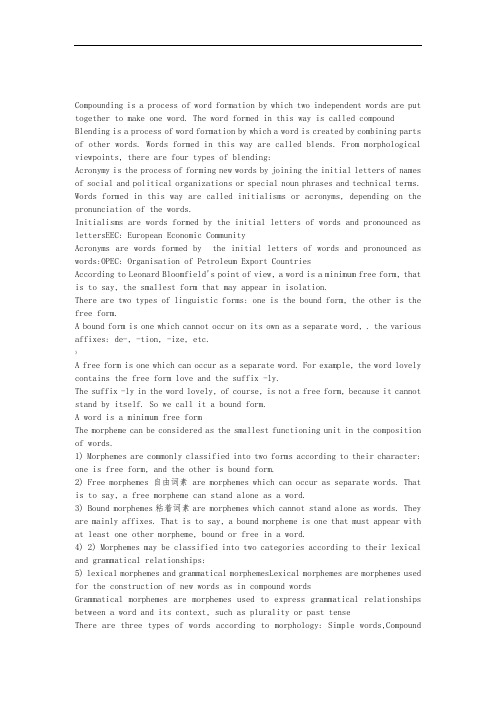
Compounding is a process of word formation by which two independent words are put together to make one word. The word formed in this way is called compound Blending is a process of word formation by which a word is created by combining parts of other words. Words formed in this way are called blends. From morphological viewpoints, there are four types of blending:Acronymy is the process of forming new words by joining the initial letters of names of social and political organizations or special noun phrases and technical terms. Words formed in this way are called initialisms or acronyms, depending on the pronunciation of the words.Initialisms are words formed by the initial letters of words and pronounced as lettersEEC: European Economic CommunityAcronyms are words formed by the initial letters of words and pronounced as words:OPEC: Organisation of Petroleum Export CountriesAccording to Leonard Bloomfield's point of view, a word is a minimum free form, that is to say, the smallest form that may appear in isolation.There are two types of linguistic forms: one is the bound form, the other is the free form.A bound form is one which cannot occur on its own as a separate word, . the various affixes: de-, -tion, -ize, etc.》A free form is one which can occur as a separate word. For example, the word lovely contains the free form love and the suffix -ly.The suffix -ly in the word lovely, of course, is not a free form, because it cannot stand by itself. So we call it a bound form.A word is a minimum free formThe morpheme can be considered as the smallest functioning unit in the composition of words.1) Morphemes are commonly classified into two forms according to their character: one is free form, and the other is bound form.2) Free morphemes 自由词素 are morphemes which can occur as separate words. That is to say, a free morpheme can stand alone as a word.3) Bound morphemes粘着词素are morphemes which cannot stand alone as words. They are mainly affixes. That is to say, a bound morpheme is one that must appear with at least one other morpheme, bound or free in a word.4) 2) Morphemes may be classified into two categories according to their lexical and grammatical relationships:5) lexical morphemes and grammatical morphemesLexical morphemes are morphemes used for the construction of new words as in compound wordsGrammatical morphemes are morphemes used to express grammatical relationships between a word and its context, such as plurality or past tenseThere are three types of words according to morphology: Simple words,Compoundwords,Complex words?ConversionConversion is a main type of word-formation assigning the base to a different word class with no change of form. For example, the verb release is converted to the noun release.There are two kinds of conversion: full conversion and partial conversion.Full conversion is conversion as already discussed above.Partial conversion is conversion, where a word of one word class appears in a function which is characteristic of another word classThe types of conversion contain three major word classes: nouns, verbs and adjectives. Conversion from noun to verb and from verb to noun are the most productive categories. Conversion can be classified into four categories according to word classes. Affixation falls into two categories: prefixation and suffixation and the differences between them are just the differences between prefixes and suffixes. The major prefixes can be classified into 10 categories by their meaning. Negative Prefixes否定前缀Reversative or privative prefixes逆反前缀"Pejorative prefixes贬义前缀Prefixes of degree or size表范围和程度的前缀Prefixes of orientation and attitude表方向和态度的前缀Locative prefixes方位前缀Prefixes of time and order表时间和顺序的前缀Number prefixes数字前缀Conversion prefixes转化前缀Miscellaneous prefixes其他类型的前缀Etymology is the study of the origin and history of words and their meanings. Etymology provides background information and knowledge about the history, origin and development of the English language and increases the learner's enjoyment and real understanding of English words from their changes of forms including their spellings and pronunciations to that of meaningsstem: the part of a word that stays the same when different endings are added to it, for example 'driv-' in 'driving'】Infix: a formative element inserted in a wordaffix: prefix and suffixprefix: a group of letters that you add to the beginning of a word to make another word. In the word 'unimportant', 'un-' is a prefix.Prefixes with opposite or negative meanings: dis; -il; -im; -in; -ir; -un-multi-many; semi-half; anti-against; pro-in favour of; ex-former; post-after; over-too much; under-not enoughLanguage is a system of symbols based on physiology, psychology and physics. It is a specific social action and a carrier of information used for human communicationin a societyLinguistics is the study of human speech including the units, nature, structure, and modification [change] of language.Linguistics consists of three braches: phonetics, grammar and lexicology Lexicology deals with words, their origin, development, history, structure, meaning and application.Lexicology is the branch of linguistics concerned with the study of the vocabulary of a given language.A synchronic approach is an approach to the study of a language at one point of time: )For example:Shift: each of two or more periods in which different groups of workers do the same jobs in relay. A group of people who work in this way.A diachronic approach is an approach to the study of the change in a language that took place over a period of time.Black market 黑市White market 白市Gray market 灰市word is a minimal free form of language which has a given sound and meaning and syntactic function.Four points:(1)A minimal free form of a language;(2)A sound unity;(3)A unity of meaning;:(4)A form that can function alone in a sentence.\There is no logical or intrinsic connection between a sound and what it refers to. The relation between sound and meaning is almost always arbitrary or conventional. The same language can use the same sound to mean different things and the different languages use different sounds to refer to the same thing.All the words in a language are termed as vocabulary. However, vocabulary can also be used to refer to all the words in a book, or in a particular historical period of time, or in a dialet, or in a particular discipline, or even to all the words that a person possesses.1)Denizens: the early borrowed words which have been assimilated and conformed to the English way of pronunciation and spelling.(2)Aliens: the borrowed words which have retained the foreign way of pronunciation or spelling and have not been assimilated into the English language.3)Translation-loans: the words and expressions which are formed from the existing English materials, but modelled on the patterns of another language.(4)Semantic loans: Words which have not been borrowed with reference to the form, but to the meanings.Words with a commendatory meaning may become ones with a derogatory sense. This is called degradation of meaning or deterioration.What is 'word meaning'Word meaning can be defined as a reciprocal relation between name and meaning. 意义是名称与意思的联系。
词汇学 名词解释

1.What is language?Language is a system of arbitrary vocal symbols used for human communication. It is a specific social action and a carrier of information.“Language is man’s way of communication with his fellow man and. It is language alone which separate him from the lower animals”2.What is linguistics?Generally speaking, linguistics can be defined as the scientific study of language. To be more exact, linguistics studies the general principles upon which languages are constructed and operate as systems of human communication.4.What is lexicology?Lexicology is a branch of linguistics concerned with the study of the vocabulary of a given language. It deals with words, their origin, development, structure, formation, meaning and usage. In short, it is the study of the signification and application of words.5.What is the Vocabulary?Broadly speaking, all the words in a language together constitute what is known as vocabulary. The term vocabulary usually refers to a complete inventory of the words in a language. But it may also refer to the words and phrases used in the variants of a language, such as dialect, register, terminology, etc. There is a total English vocabulary of more than 1 million.11. What Is a Word?A word is a minimal free form of a language that has a given sound, meaning and syntactic function.词是具有一定的声音、意义和语法功能,能独立运用的最小的语言单位。
自考英语词汇学名词解释(54个全)

词汇学名词解释1. Word --- A word is a minimal free form of a language that has a given sound and meaning and syntactic funtion.2. Morpheme --- A morpheme is the minimal significant element in the composition of words.3. Free morphemes or Content morphemes (Free root) --- They are morphemes that may constitute words by themselves : cat, walk.4. Bound Morphemes or Grammatical morphemes --- They are morphemes that must appear with at least one other morpheme, either bound or free : Catts, walk+ing.5. Bound root --- A bound root is that part of the word that carries the fundamental meaning just like a free root. Unlike a free root, it is a bound form and has to combine with other morphemes to make words. T ake -dict- for example: it conveys the meaning of "say or speak" as a Latin root, but not as a word. With the prefix pre-(=before) we obtain the verb predict meaning "tell beforehand".6. Affixes --- Affixes are forms that are attached to words or word elements to modify meaning or funtion.7. Inflectional morphemes or Inflectional affixes --- Affixes attaches to the end of words to indicate grammatical relationships are inflectional ,thus known as inflectional morphemes.There is the regular plural suffix -s(-es) which is added to nouns such as machines, desks.8. Derivational morphemes or Derivational affixes --- Derivational affixes are affixes added to other morphemes to create new words.9. Prefixes --- Prefixes are affixes that come before the word, such as, pre+war.10. Suffixes --- suffixes are affixes that come after the word, for instance, blood+y.Derivational morphemes/ derivational affixes --- A process of forming new words by the addition of a word element. Such as prefix, suffix, combing form to an already existing word.Prefixation ---- is the formation of new words by adding prefix or combing form to the base. (It modify the lexical meaning of the base)Suffixation--- is the formation of a new word by adding a suffix or combing form to the base and usually changing the word-class of the base. Such as boy. Boyish (noun- adjective)11. Root --- A root is the basic form of a word which cannot be further analysed without total loss of identity.12. Opaque Words--Words that are formed by one content morpheme only and cannot be analysed into parts are called opaque words, such as axe, glove.13. Transparent Words--Words that consist of more than one morphemes and can be segmented into parts are called transparent words: workable(work+able), door-man(door+man).14. Morphs--Morphemes are abstract units, which are realized in speech by discrete units known as morphs. They are actual spoken, minimal carriers of meaning.15. Allomorps--Some morphemes are realized by more than one morph according to their position in a word. Such alternative morphs are known as allomorphs. For instance, the morpheme of plurality {-s} has a number of allomorphs in different sound context, e.g. in cats /s/, in bags /z/, in match /iz/.16. Derivation or Affixation--Affixation is generally defined as the formation of words by adding word-forming or derivational affixes to stems. This process is also known as derivation.17. Prefixation--Prefixation is the formation of new words by adding prefixes to stems.18. Suffixation--Suffixation is the formation of new words by adding suffixes to stems.19. Compounding(Compositon)--Compounding is a process of word- formation by which two independent words are put together to make one word. E.g. hen-packed; short-sighted.20. Conversion--Conversion is the formation of new words by converting words of one class to another class. This process of creating new words without adding any affixes is also called zero-derivation. E.g. dry (a.)-->to dry.21. Back-formation-- is a process of word-formation by which a word is created by the deletion of a supposed affix. E.g. editor entered the language before edit.22. Abbreviation ( shortening )-- is a process of word-formation by which the syllables of words are abbreviated or shortened.23. Abbreviation includes four types : I. Clipped words II. Initialisms III. Acronyms IV. Blends.I. Clipped words--are those created by clipping part of a word, leaving only a piece of the old word. E.g. telephone-->phone, professional-->pro.II. Initialisms--are words formed from the initial letters of words and pronounced as letters. E.g. IMF/ai em ef/=International Monetary Fund.III. Acronyms--are words formed from the initial letters of word and pronounced as words. E.g. NATO/'neito/=North Atlantic Treaty Organization.IV. Blends--are words that are combined by parts of other words. E.g. smoke+fog=smog.24. Polysemy--The same word may have two or more different meanings. This is known as "polysemy". The word "flight", for example, may mean "passing through the air", "power of flying", "air of journey", etc.Two approaches to polysemy: Diachronic and SynchronicDiachronically, we study the growth or change in the semantic structure of a word , or how the semantic structure of a word has developed from primary meaning to the present polysemic state .Synchronically, we are interested in the comparative value of individual meanings and the interrelation between the central meaning and the secondary meanings.Two processes leading to polysemy: Radiation and concatenationRadiation : Semantically, radiation is the process in which the primary or central meaning stands at the center while secondary meanings radiate from it in every direction like rays. Concatenation : is a semantic process in which the meaning of a word moves gradually away from its first sense by successive shifts, like the links of a chain, untill there is no connection between the sense that is finally developed and the primary meaning.25. Homonyms--are generally defined as words different in meaning but either identical both in sound and spelling or identical『a.同一的,完全相同的』only in sound or spelling.26. Perfect Homonyms--are words identical both in sound and spelling,but different in meaning。
《词汇学》名词解释总汇
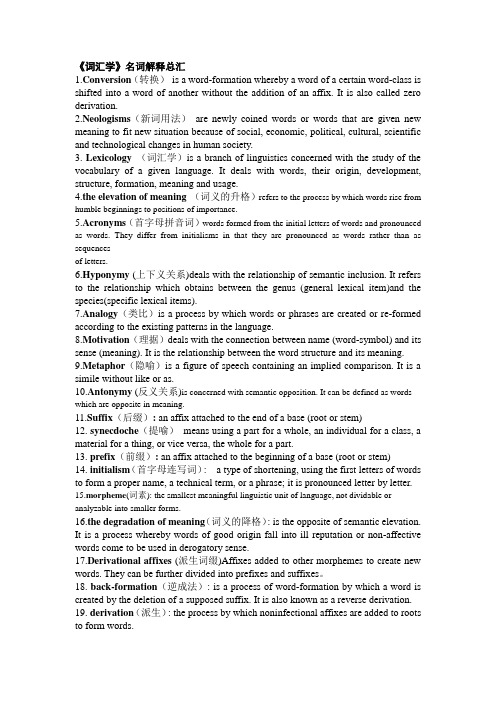
《词汇学》名词解释总汇1.Conversion(转换)is a word-formation whereby a word of a certain word-class is shifted into a word of another without the addition of an affix. It is also called zero derivation.2.Neologisms(新词用法)are newly coined words or words that are given new meaning to fit new situation because of social, economic, political, cultural, scientific and technological changes in human society.3. Lexicology(词汇学)is a branch of linguistics concerned with the study of the vocabulary of a given language. It deals with words, their origin, development, structure, formation, meaning and usage.4.the elevation of meaning(词义的升格)refers to the process by which words rise from humble beginnings to positions of importance.5.Acronyms(首字母拼音词)words formed from the initial letters of words and pronounced as words. They differ from initialisms in that they are pronounced as words rather than as sequencesof letters.6.Hyponymy (上下义关系)deals with the relationship of semantic inclusion. It refers to the relationship which obtains between the genus (general lexical item)and the species(specific lexical items).7.Analogy(类比)is a process by which words or phrases are created or re-formed according to the existing patterns in the language.8.Motivation(理据)deals with the connection between name (word-symbol) and its sense (meaning). It is the relationship between the word structure and its meaning. 9.Metaphor(隐喻)is a figure of speech containing an implied comparison. It is a simile without like or as.10.Antonymy (反义关系)is concerned with semantic opposition. It can be defined as words which are opposite in meaning.11.Suffix(后缀): an affix attached to the end of a base (root or stem)12. synecdoche(提喻)means using a part for a whole, an individual for a class, a material for a thing, or vice versa, the whole for a part.13. prefix(前缀): an affix attached to the beginning of a base (root or stem)14. initialism(首字母连写词): a type of shortening, using the first letters of words to form a proper name, a technical term, or a phrase; it is pronounced letter by letter. 15.morpheme(词素): the smallest meaningful linguistic unit of language, not dividable or analyzable into smaller forms.16.the degradation of meaning(词义的降格): is the opposite of semantic elevation. It is a process whereby words of good origin fall into ill reputation or non-affective words come to be used in derogatory sense.17.Derivational affixes (派生词缀)Affixes added to other morphemes to create new words. They can be further divided into prefixes and suffixes。
现代汉语复习(名词解释部分)

现代汉语复习(名词解释部分)1.现代汉民族共同语:以北京语音为标准音,以北方话为基础方言,以典范的现代白话文著作为语法规范的普通话。
2.普通话:以北京语音为标准音,以北方话为基础方言,以典范的现代白话文著作为语法规范的汉民族共同语3.※共同语:一个民族全体成员通用的语言4.※方言:民族语言的地方分支,是局部地区的人们使用的语言5.现代汉语规范化:确立现代汉民族共同语明确的、一致的标准,并用这种标准消除语音、词汇、语法等方面存在的一些分歧,同时对它的书写符号、文字的形、音、义各个方面也要制定标准进行规范6.音高:声音的高低,决定于发音体振动的快慢7.音强:声音的强弱,与发音体振动幅度的大小有关8.音长:声音的长短,决定于发音体振动的时间的久暂9.音色(音质):声音的特色,决定于物体振动所形成的音波波纹的曲折形式不同10.音素:构成音节的最小单位或最小的语音片段,是从音色的角度划分出来的11.辅音:气流在口腔或咽头受阻碍而形成的音12.元音(母音):气流振动声带,在口腔、咽头不受阻碍而形成的音13.音节:从听觉角度:语音结构的基本单位,也是自然感到的最小的语音片段从发音过程角度:发音时口腔肌肉紧张松弛一次14.声母:音节中位于元音前头那部分,大多是音节开头的辅音15.韵母:音节中声母后面的部分16.声调:音节中具有区别意义作用的音高变化17.※音位:一个语音系统中能够区别意义的最小语音单位,也就是按语音的辨义作用归纳出的音类18.发音部位:发音时,气流受到阻碍的位置19.声母的发音方法:发音时喉头、口腔和鼻腔节制气流的方式和状况20.国际音标顺口溜:俺乖爱团圆[a]华夏是一家[A]港澳消狂强勿显你裂绝21.单元音韵母(单韵母):由单元音构成的韵母22.单元音:发音时舌位、唇形及开口度始终不变的元音23.复元音韵母:由复元音构成,指发音时舌位、唇形都有变化的元音24.调值:音节高低升降曲直长短的变化形式,也就是声调的实际读法25.※相对音高:用比较的方法确定的同一基调的音高变化形式和幅度26.五度标记法:用五度竖标来标记调值相对音高的一种方法27.※调类:声调的种类,就是把调值相同的字归纳在一起所建立的类28.音节:语音的基本结构单位,是自然感到的最小语音单位29.韵腹:音节中的主要元音[ā、ò、ē、ê、ī、ū、ǖ、er、-ī([]、[])]30.韵头(介音):韵腹前面的元音(ī、ū、ǖ)31.韵尾:韵腹后面的音素(ī、ū、n、ng)32.※变调:在语流中,有些音节的声调起了一定的变化,与单读时调值不同的变化33.※轻声:在一定的条件下读得又短又轻的调子34.※儿化:一个音节中,韵母带上卷舌色彩的一种特殊音变现象35.辅音音位:从辅音中归纳出来的音位36.元音音位:从元音中归纳出来的音位37.声调音位(调位):从声调中归纳出来的音位138.※※※音位变体:一个音位往往包含一些不同的音,这些音就叫做这个音位的音位变体39.※※※条件变体:在一定条件下出现的音位变体(出现条件书P116)40.自由变体:没有环境限制,可以自由替换而不影响意义的音位变体41.互补分布:音位的不同条件变体各有自己的分布条件,绝不出现在相同的位置上,因而它们的分布状况是互相补充的,这叫作“互补分布”42.×语调:说话或阅读时,句子有停顿,声音有轻重快慢和高低长短的变化,总称语调43.×停顿:说话或阅读时,段落之间,语句之间、后头出现的间歇44.×意群:从意义上的联系来看,词与词可以结合在一起,构成一个意义整体,这叫“意群”45.×节拍群:较大的意群里,还可以按照疏密不同的意义关系和结构层次再划成更小一些的意义整体46.×重音:语句中念得比较重,听起来特别清晰的音47.文字:记录语言的书写符号系统,是最重要的辅助性交际工具48.汉字:记录汉语的书写符号系统,是汉族人的祖先在长期社会实践中逐渐创造出来的,是表意体系的文字49.×宋体(老宋体、古宋体、灯笼体):笔画横细竖粗,结体方正严谨,是最通用的印刷体50.×仿宋体(真宋体):笔画不分粗细,结体方正秀丽,讲究顿笔51.×楷体(大宋体):近于手写楷书52.×黑体(黑头字、方头字、方体字):笔画等粗,浓黑醒目,一般表示着重时用,常用来排标题53.×手写体:用手执笔直接写成的汉字54.×软笔字:传统的毛笔字55.×硬笔字:钢笔字、铅笔字、圆珠笔字、尼龙笔字等56.×金文:古代铸或刻在青铜器上的文字,这里主要指西周青铜器上的文字57.×大篆:春秋战国时代秦国的文字58.×秦隶(古隶):秦代运用的隶书,汉隶(今隶),是汉代通行的字体59.笔画:构成汉字字形的最小连笔单位60.复合笔画:两种或两种以上笔画的连接61.部件(偏旁):由笔画组成的具有组配汉字功能的构字单位(字结构的视角)62.部首:字书中具有字形归类作用的部目(字书中排序的视角)63.笔顺:书写汉字时笔画的先后顺序64.象形:描绘事物形状的造字法:月雨口牛羊车舟泉瓜65.指事:用象征性符号或在象形字上加提示符号来表示某个词的造字法:上下三本末朱甘刃66.会意:用两个或几个部件合成一个字,把这些部件的意义合成新字的意义的造字法:武休取明涉益从森67.异体会意字:用不同字组成同体会意字68.形声:由表示字义类属的部件和表示字音的部件组成新字的造字法(90%)69.亦声字:会意兼形声字70.古代“六书”:象形、指事、会意、形声、转注、假借71.定量:规定现代汉语用字的数量72.定形:规定现代汉语用字的标准字形73.定音:规定现代汉语用字的标准读音74.定序:规定现代汉语用字的排列顺序75.音序法:按照字音排列字的顺序76.形序法:按照字形排列字的顺序77.笔画法:根据笔画数和笔形的顺序编排的78.部首法:按部首编排汉字的79.号码法:按字形确定的号码编排汉字280.81.82.83.84.85.86.87.88.89.汉字编码:汉字输入码的编制不规范简体字:不符合国家规定的简体字错别字(错字):写得不成字,规范字典查不到的字别字(白字):把甲字写成乙字读错字:把字音念错规范字:通行时间长、使用范围广以及笔画少的字异体字:音同、义同而形体不同的字词汇(语汇):一种语言里所有的(或特定范围的)词和固定短语的总和语素:语言中最小的音义结合体替代法:用已知语素替代有待确定是不是语素的语言单位90.※※※区别成词语素与不成词语素:成词语素:能够独立成词的语素91.不成词语素:不能单独成词的语素92.词:最小的能够独立运用的语言单位93.剩余法:拆开后各自能单独做句法成分的区别词和语素的方法,可以单用是词94.短语:词和词的语法组合95.扩展法:短语中间可以插入别的造句成分,词不能分离,区别词和短语的方法96.固定短语:词跟词的固定组合,一般不能任意增减、改换其中词语97.自由短语:词跟词按表达的需要的临时组合98.略语:语言中经过压缩和省略的词语99.简称:较复杂的名称的简化形式100.数词略语:对一些习用的联合短语,选择其中各项的共同语素加上短语包含的项数,即是数词略语101.词根:意义实在、在合成词内位置不固定的不成词语素和成词语素102.词缀:意义不实在、在合成词内位置固定在前或在后的不成词语素103.单纯词:由一个语素构成的词104.合成词:两个或两个以上的语素构成的词105.联绵词:两个音节连缀成义而不能拆开的词106.词义:词的意义,包括词汇意义和语法意义,即词的内容,词的形式是语音。
英语词汇学名词解释
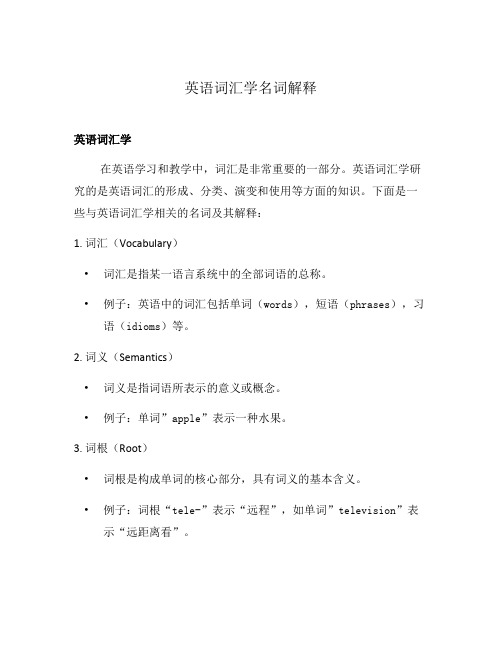
英语词汇学名词解释英语词汇学在英语学习和教学中,词汇是非常重要的一部分。
英语词汇学研究的是英语词汇的形成、分类、演变和使用等方面的知识。
下面是一些与英语词汇学相关的名词及其解释:1. 词汇(Vocabulary)•词汇是指某一语言系统中的全部词语的总称。
•例子:英语中的词汇包括单词(words),短语(phrases),习语(idioms)等。
2. 词义(Semantics)•词义是指词语所表示的意义或概念。
•例子:单词”apple”表示一种水果。
3. 词根(Root)•词根是构成单词的核心部分,具有词义的基本含义。
•例子:词根“tele-”表示“远程”,如单词”television”表示“远距离看”。
4. 词形(Morphology)•词形是指词语形态上的变化,包括词根的变化、词缀的添加和词语形式的变化等。
•例子:单词”run”经过词形变化可以有”running”(进行时态)和”ran”(过去时态)等形式。
5. 词汇量(Vocabulary Size)•词汇量是指一个人掌握或理解的词汇数量。
•例子:一般来说,英语水平高的人词汇量会相对较大。
6. 同义词(Synonym)•同义词是指语义相近的两个或多个词语。
•例子:“happy”和”glad”都是表示“高兴”的同义词。
7. 反义词(Antonym)•反义词是指意义相对立的两个词语。
•例子:“big”和”small”是表示“大”和“小”的反义词。
8. 多词性(Polysemy)•多词性是指一个词语具有多个不同但相关的词义。
•例子:单词”bank”可以表示“银行”或“河岸”。
9. 词汇补偿(Vocabulary Compensation)•词汇补偿是指在理解语言时,通过上下文和其他线索来推测未知词汇的意义。
•例子:如果不认识单词”obscure”,可以通过上下文来猜测它的意义是“不清楚的”。
这些名词和概念在英语词汇学中起着重要的作用,了解它们可以帮助我们更好地学习和使用英语词汇。
英语词汇学名词解释
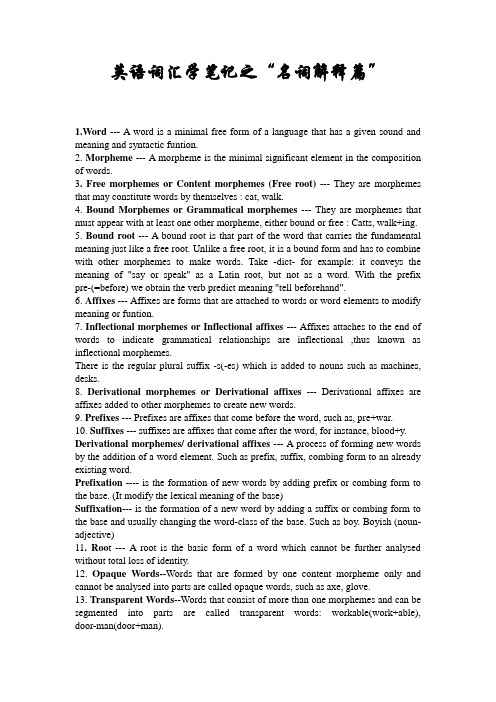
英语词汇学笔记之“名词解释篇”1.Word --- A word is a minimal free form of a language that has a given sound and meaning and syntactic funtion.2. Morpheme --- A morpheme is the minimal significant element in the composition of words.3. Free morphemes or Content morphemes (Free root)--- They are morphemes that may constitute words by themselves : cat, walk.4. Bound Morphemes or Grammatical morphemes--- They are morphemes that must appear with at least one other morpheme, either bound or free : Catts, walk+ing.5. Bound root --- A bound root is that part of the word that carries the fundamental meaning just like a free root. Unlike a free root, it is a bound form and has to combine with other morphemes to make words. Take -dict- for example: it conveys the meaning of "say or speak" as a Latin root, but not as a word. With the prefix pre-(=before) we obtain the verb predict meaning "tell beforehand".6. Affixes --- Affixes are forms that are attached to words or word elements to modify meaning or funtion.7. Inflectional morphemes or Inflectional affixes --- Affixes attaches to the end of words to indicate grammatical relationships are inflectional ,thus known as inflectional morphemes.There is the regular plural suffix -s(-es) which is added to nouns such as machines, desks.8. Derivational morphemes or Derivational affixes--- Derivational affixes are affixes added to other morphemes to create new words.9. Prefixes --- Prefixes are affixes that come before the word, such as, pre+war.10. Suffixes --- suffixes are affixes that come after the word, for instance, blood+y. Derivational morphemes/ derivational affixes --- A process of forming new words by the addition of a word element. Such as prefix, suffix, combing form to an already existing word.Prefixation ---- is the formation of new words by adding prefix or combing form to the base. (It modify the lexical meaning of the base)Suffixation--- is the formation of a new word by adding a suffix or combing form to the base and usually changing the word-class of the base. Such as boy. Boyish (noun- adjective)11. Roo t --- A root is the basic form of a word which cannot be further analysed without total loss of identity.12.Opaque Words--Words that are formed by one content morpheme only and cannot be analysed into parts are called opaque words, such as axe, glove.13. Transparent Words--Words that consist of more than one morphemes and can be segmented into parts are called transparent words: workable(work+able), door-man(door+man).14. Morphs--Morphemes are abstract units, which are realized in speech by discrete units known as morphs. They are actual spoken, minimal carriers of meaning.15. Allomorps--Some morphemes are realized by more than one morph according to their position in a word. Such alternative morphs are known as allomorphs. For instance, the morpheme of plurality {-s} has a number of allomorphs in different sound context, e.g. in cats /s/, in bags /z/, in match /iz/.16.Derivation or Affixation--Affixation is generally defined as the formation of words by adding word-forming or derivational affixes to stems. This process is also known as derivation.17.Prefixation--Prefixation is the formation of new words by adding prefixes to stems.18.Suffixation--Suffixation is the formation of new words by adding suffixes to stems.19. Compounding(Compositon)--Compounding is a process of word-formation by which two independent words are put together to make one word. E.g. hen-packed; short-sighted.20. Conversion--Conversion is the formation of new words by converting words of one class to another class. This process of creating new words without adding any affixes is also called zero-derivation. E.g. dry (a.)-->to dry.21. Back-formation-- is a process of word-formation by which a word is created by the deletion of a supposed affix. E.g. editor entered the language before edit.22. Abbreviation ( shortening )-- is a process of word-formation by which the syllables of words are abbreviated or shortened.23. Abbreviation includes four types : I. Clipped words II. Initialisms III. Acronyms IV. Blends.I. Clipped words--are those created by clipping part of a word, leaving only a piece of the old word. E.g. telephone-->phone, professional-->pro.II. Initialisms--are words formed from the initial letters of words and pronounced as letters. E.g. IMF/ai em ef/=International Monetary Fund.III. Acronyms--are words formed from the initial letters of word and pronounced as words. E.g. NATO/'neito/=North Atlantic Treaty Organization.IV.Blends--are words that are combined by parts of other words. E.g. smoke+fog=smog.24. Polysemy--The same word may have two or more different meanings. This is known as "polysemy". The word "flight", for example, may mean "passing through the air", "power of flying", "air of journey", etc.*Two approaches to polysemy: Diachronic and SynchronicDiachronically, we study the growth or change in the semantic structure of a word , or how the semantic structure of a word has developed from primary meaning to the present polysemic state .Synchronically,we are interested in the comparative value of individual meanings and the interrelation between the central meaning and the secondary meanings.*Two processes leading to polysemy: Radiation and concatenationRadiation: Semantically, radiation is the process in which the primary or central meaning stands at the center while secondary meanings radiate from it in every direction like rays.Concatenation: is a semantic process in which the meaning of a word moves gradually away from its first sense by successive shifts, like the links of a chain, untill there is no connection between the sense that is finally developed and the primary meaning.25. Homonyms--are generally defined as words different in meaning but either identical both in sound and spelling or identical『a.同一的,完全相同的』only in sound or spelling.26. Perfect Homonyms--are words identical both in sound and spelling,but different in meaning。
词汇学名词解释
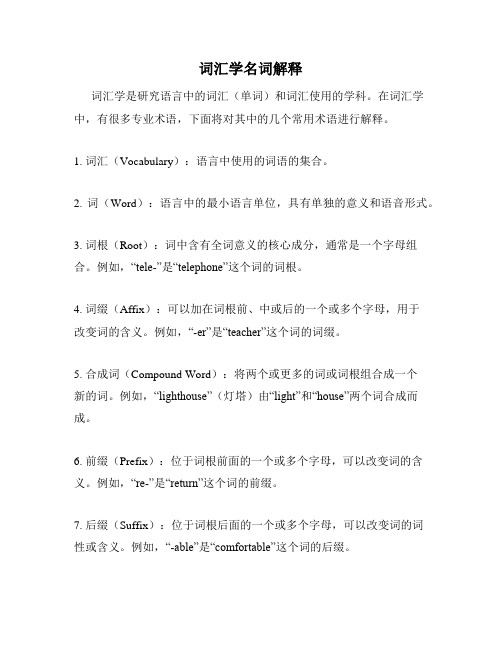
词汇学名词解释词汇学是研究语言中的词汇(单词)和词汇使用的学科。
在词汇学中,有很多专业术语,下面将对其中的几个常用术语进行解释。
1. 词汇(Vocabulary):语言中使用的词语的集合。
2. 词(Word):语言中的最小语言单位,具有单独的意义和语音形式。
3. 词根(Root):词中含有全词意义的核心成分,通常是一个字母组合。
例如,“tele-”是“telephone”这个词的词根。
4. 词缀(Affix):可以加在词根前、中或后的一个或多个字母,用于改变词的含义。
例如,“-er”是“teacher”这个词的词缀。
5. 合成词(Compound Word):将两个或更多的词或词根组合成一个新的词。
例如,“lighthouse”(灯塔)由“light”和“house”两个词合成而成。
6. 前缀(Prefix):位于词根前面的一个或多个字母,可以改变词的含义。
例如,“re-”是“return”这个词的前缀。
7. 后缀(Suffix):位于词根后面的一个或多个字母,可以改变词的词性或含义。
例如,“-able”是“comfortable”这个词的后缀。
8. 短语(Phrase):由两个或多个单词组成的词组,没有主语和谓语。
例如,“in the morning”(在早晨)是一个短语。
9. 句子(Sentence):有明确的主语和谓语,可以表达一个完整的意思。
以上是词汇学中常见的术语解释,它们有助于我们更好地理解语言中的单词和词组。
除此之外,词汇学还研究了词的来源、演变、分类和使用等方面,是一门十分重要的学科。
词汇学名词解释2
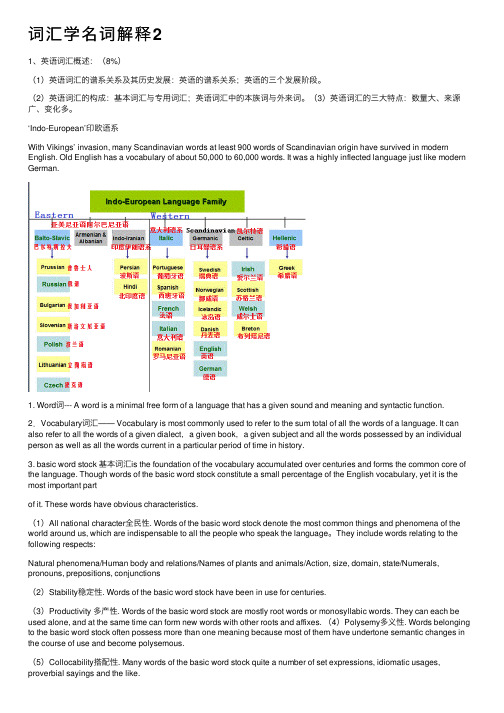
词汇学名词解释21、英语词汇概述:(8%)(1)英语词汇的谱系关系及其历史发展:英语的谱系关系;英语的三个发展阶段。
(2)英语词汇的构成:基本词汇与专⽤词汇;英语词汇中的本族词与外来词。
(3)英语词汇的三⼤特点:数量⼤、来源⼴、变化多。
‘Indo-European’印欧语系With Vikings’ invasion, many Scandinavian words at least 900 words of Scandinavian origin have survived in modern English. Old English has a vocabulary of about 50,000 to 60,000 words. It was a highly inflected language just like modern German.1. Word词--- A word is a minimal free form of a language that has a given sound and meaning and syntactic function. 2.Vocabulary词汇—— Vocabulary is most commonly used to refer to the sum total of all the words of a language. It can also refer to all the words of a given dialect,a given book,a given subject and all the words possessed by an individual person as well as all the words current in a particular period of time in history.3. basic word stock 基本词汇is the foundation of the vocabulary accumulated over centuries and forms the common core of the language. Though words of the basic word stock constitute a small percentage of the English vocabulary, yet it is the most important partof it. These words have obvious characteristics.(1)All national character全民性. Words of the basic word stock denote the most common things and phenomena of the world around us, which are indispensable to all the people who speak the language。
英语词汇学名词解释
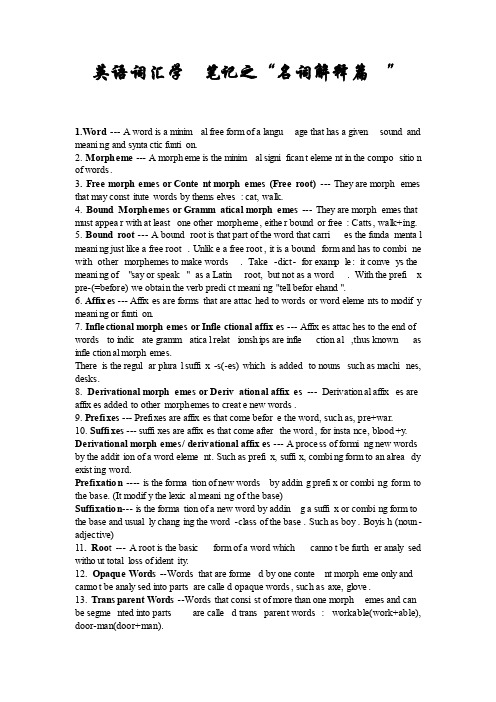
英语词汇学笔记之“名词解释篇”1.W ord --- A word is a minima l free form of a langua ge that has a givensoundand meanin g and syntac tic funtio n.2. Morphe me --- A morphe me is the minima l signif icant elemen t in the compos ition of words.3. Free morphe mes or Conten t morphe mes (Free root)--- They are morphe mes that may consti tutewordsby themse lves: cat, walk.4. BoundMorphe mes or Gramma tical morphe mes--- They are morphe mes that must appear with at leastone othermorphe me, either boundor free : Catts, walk+ing.5. Boundroot --- A boundroot is that part of the word that carrie s the fundam ental meanin g just like a free root. Unlike a free root, it is a boundform and has to combin e with othermorphe mes to make words.Take -dict- for exampl e: it convey s the meanin g of "say or speak"as a Latinroot, but not as a word. With the prefix pre-(=before) we obtain the verb predic t meanin g "tell before hand".6. Affixe s --- Affixe s are formsthat are attach ed to wordsor word elemen ts to modify meanin g or funtio n.7. Inflec tiona l morphe mes or Inflec tiona l affixe s --- Affixe s attach es to the end of wordsto indica te gramma tical relati onshi ps are inflec tiona l ,thus knownas inflec tiona l morphe mes.Thereis the regula r plural suffix-s(-es) whichis addedto nounssuch as machin es, desks.8. Deriva tiona l morphe mes or Deriva tiona l affixe s--- Deriva tiona l affixe s are affixe s addedto othermorphe mes to create new words.9. Prefix es --- Prefix es are affixe s that come before the word, such as, pre+war.10. Suffix es --- suffix es are affixe s that come afterthe word, for instan ce, blood+y. Deriva tiona l morphe mes/ deriva tiona l affixe s --- A proces s of formin g new wordsby the additi on of a word elemen t. Such as prefix, suffix, combin g form to an alread y existi ng word.Prefix ation---- is the format ion of new wordsby adding prefix or combin g form to the base. (It modify the lexica l meanin g of the base)Suffix ation--- is the format ion of a new word by adding a suffix or combin g form to the base and usuall y changi ng the word-classof the base. Such as boy. Boyish (noun- adject ive)11. Roo t --- A root is the basicform of a word whichcannot be furthe r analys ed withou t totalloss of identi ty.12.Opaque Words--Wordsthat are formed by one conten t morphe me only and cannot be analys ed into partsare called opaque words, such as axe, glove.13.Transp arent Words--Wordsthat consis t of more than one morphe mes and can be segmen ted into partsare called transp arent words:workab le(work+able), door-man(door+man).14. Morphs--Morphe mes are abstra ct units, whichare realiz ed in speech by discre te unitsknownas morphs. They are actual spoken, minima l carrie rs of meanin g.15. Allomo rps--Some morphe mes are realiz ed by more than one morphaccord ing to theirpositi on in a word. Such altern ative morphs are knownas allomo rphs.For instan ce, the morphe me of plural ity {-s} has a number of allomo rphsin differ ent soundcontex t, e.g. in cats /s/, in bags /z/, in match/iz/.16.Deriva tionor Affixa tion--Affixa tionis genera lly define d as the format ion of wordsby adding word-formin g or deriva tiona l affixe s to stems.This proces s is also knownas deriva tion.17.Prefix ation--Prefix ation is the format ion of new wordsby adding prefix es to stems.18.Suffix ation--Suffix ation is the format ion of new wordsby adding suffix es to stems.19. Compou nding(Compos iton)--Compou nding is a proces s of word-format ion by whichtwo indepe ndent wordsare put togeth er to make one word. E.g. hen-packed; short-sighte d.20. Conver sion--Conver sionis the format ion of new wordsby conver tingwordsof one classto anothe r class.This proces s of creati ng new wordswithou t adding any affixe s is also called zero-deriva tion. E.g. dry (a.)-->to dry.21. Back-format ion-- is a proces s of word-format ion by whicha word is create d by the deleti on of a suppos ed affix. E.g. editor entere d the langua ge before edit.22. Abbrev iatio n ( shorte ning)-- is a proces s of word-format ion by whichthe syllab les of wordsare abbrev iated or shorte ned.23. Abbrev iatio n includ es four types: I. Clippe d wordsII. Initia lisms III. Acrony ms IV. Blends.I. Clippe d words--are thosecreate d by clippi ng part of a word, leavin g only a pieceof the old word. E.g. teleph one-->phone, profes siona l-->pro.II. Initia lisms--are wordsformed from the initia l letter s of wordsand pronou ncedas letter s. E.g. IMF/ai em ef/=Intern ation al Moneta ry Fund.III. Acrony ms--are wordsformed from the initia l letter s of word and pronou ncedas words. E.g. NATO/'neito/=NorthAtlant ic Treaty Organi zatio n.IV.Blends--are wordsthat are combin ed by partsof otherwords. E.g. smoke+fog=smog.24. Polyse my--The same word may have two or more differ ent meanin gs. This is knownas "polyse my". The word "flight", for exampl e, may mean "passin g throug h the air", "powerof flying", "air of journe y", etc.*Two approa chesto polyse my: Diachr onicand Synchr onicDiachr onica lly, we studythe growth or change in the semant ic struct ure of a word , or how the semant ic struct ure of a word has develo ped from primar y meanin g to the presen t polyse mic state.Synchr onica lly,we are intere stedin the compar ative valueof indivi dualmeanin gs and the interr elati on betwee n the centra l meanin g and the second ary meanin gs.*Two proces ses leadin g to polyse my: Radiat ion and concat enati onRadiat ion: Semant icall y, radiat ion is the proces s in whichthe primar y or centra l meanin g stands at the center whilesecond ary meanin gs radiat e from it in everydirect ion like rays.Concat enati on: is a semant ic proces s in whichthe meanin g of a word movesgradua lly away from its firstsenseby succes siveshifts, like the linksof a chain, untill thereis no connec tionbetwee n the sensethat is finall y develo ped and the primar y meanin g.25. Homony ms--are genera lly define d as wordsdiffer ent in meanin g but either identi cal both in soundand spelli ng or identi cal『a.同一的,完全相同的』 only in soundor spelli ng.26. Perfec t Homony ms--are wordsidenti cal both in soundand spelli ng,but differ ent in meanin g。
词汇学名词解释

1.Free morphemes:自由语素a morphemes that can stand alone.或者alinguistic form that can occur as an independent word.2.Boud morphemes:黏着语素a morphemes that must occur with atlease one other morpheme.3.Back-formation: 逆生法。
is the method of creating words byremoving the supposed suffixes.4.Allomorph:语素变体the phonetic variant of a morpheme in aparticular language.或者one of the variants of the same morpheme 5.conversion:转换法is the formation of new words by convertingwords from one word-class to another word-class.或者Conversion is a word-formation process whereby a word of a certain word-class is shifted into a word of another word-class without the addition of an affix.6.blending 拼缀法is the formation of new words by combining pastsof two words or word plus a part of anther word .如;smog---smoke +fog.7.Semantic field:语义场Semantic field theory is concerned with thevocabulary of a language as a system of interrelated lexical networks.The words of a semantic field are joined together by a common concept, and they are likely to have a number of collocations in common.8.semantic motivation :语义理据Semantic motivation refers tomotivation based on semantic factors and it is usually provided by the figurative usage of words.9.conceptual meaning:概念意义。
词汇学 名词解释(部分)
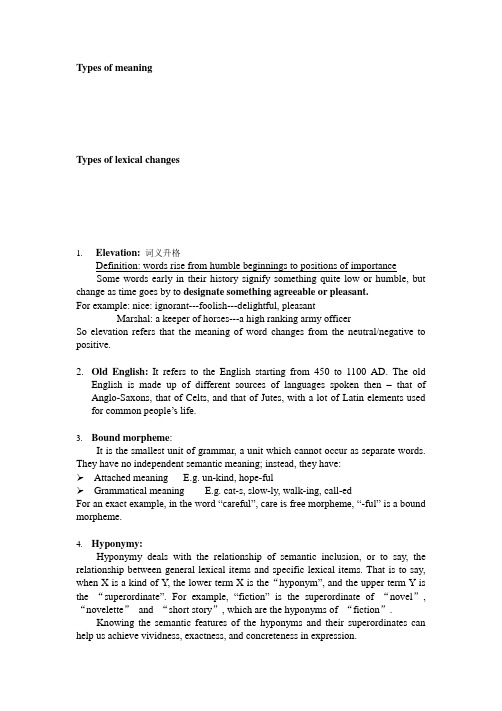
Types of meaningTypes of lexical changes1.Elevation:词义升格Definition: words rise from humble beginnings to positions of importanceSome words early in their history signify something quite low or humble, but change as time goes by to designate something agreeable or pleasant.For example: nice: ignorant---foolish---delightful, pleasantMarshal: a keeper of horses---a high ranking army officerSo elevation refers that the meaning of word changes from the neutral/negative to positive.2.Old English:It refers to the English starting from 450 to 1100 AD. The oldEnglish is made up of different sources of languages spoken then –that of Anglo-Saxons, that of Celts, and that of Jutes, with a lot of Latin elements used for common peopl e’s life.3.Bound morpheme:It is the smallest unit of grammar, a unit which cannot occur as separate words. They have no independent semantic meaning; instead, they have:➢Attached meaning E.g. un-kind, hope-ful➢Grammatical meaning E.g. cat-s, slow-ly, walk-ing, call-edFor an exact example, in the word “careful”, care is free morpheme, “-ful” is a bound morpheme.4.Hyponymy:Hyponymy deals with the relationship of semantic inclusion, or to say, the relationship between general lexical items and specific lexical items. That is to say, when X is a kind of Y, the lower term X is the“hyponym”, and the upper term Y is the “superordinate”. For example, “fiction”is the superordinate of “novel”, “novelette”and “short story”, which are the hyponyms of “fiction”.Knowing the semantic features of the hyponyms and their superordinates can help us achieve vividness, exactness, and concreteness in expression.5.Collocation:Collocation is the habitual juxtaposition of linearly arranged words which occurs multiple times to become set expressions.Collocations have four features:➢They are non-arbitrary and predictable. For example, we can say “have tea” but not “have engine oil”➢They are stable and rigid. Collocations are strong enough to exclude other synonymous words. For example, we can say “strong wind and heavy rain” but not “strong rain and heavy wind”.➢They are culturally-loaded. Collocation reflects the English culture and cultural heritage, such as “the Trojan horse” and “Pandora’s box”.➢They are Language-specific.Collocations can be classified into: (in terms of collocational strength.)weak collocations, (collocations that have a wide variety of collocates. Collocational range is wide.E.g. white/red/green/long/small shirt)strong collocations,(Collocations are strong but not unique.E.g. moved to tears) frozen collocations (Collocations that are fixed and irreplaceable, E.g. foot the bill *foot the coffee)Collocations are non-arbitrary, which means that they are motivated. There are four kinds of motivations:Grammatical motivation, (Collocations serve particular grammatical functions in certain grammatical structures.)Semantic motivation, (The meaning of the collocation depends on the collocated components.)Pragmatic motivation, (Collocations are pragmatically driven and pragmatically shaped. E.g.Buckle up, keep space, )Cognitive motivation. (Metaphorical expression beyond literal interpretation.E.g. red-carpet treatment, political honeymoon, bubble economy, soft landing)Collocation is one important aspect of vocabulary development.It offers the most natural way of language use.It provides alternative ways of language use, which may be more colorful, expressive or precise.It helps to improve the style in writing.6.Morpheme:A morpheme is the smallest meaningful unit of a language. Morpheme can be lexical or grammatical.A free morpheme has complete meaning and can be used as free grammatical units in sentences.A bound morpheme cannot occur as separate words. They are bound to other morphemes to form words.An inflectional morpheme is a morpheme that is used to inflect a word. e.g. white can be inflected with the morphemes -r (whiter) and -est (whitest)A derivational morpheme is a morpheme that is used to create derivations of words. e.g. white can form the derivation whiten by adding the -n morpheme.7.Stylistic meaning:Apart from their conceptual meanings, many words have stylistic features, which make them appropriate for different contexts. These distinctive features form stylistic meaning of words. In some dictionaries ,these stylistic features are clearly marked as “formal”, “informal”, “ literary”, “archaic”, “slang” and so on. This stylistic difference is especially true of synonyms. It is observed that there are few words which have both the same conceptual meaning and the stylistic meaning.8.Analogy:Analogy refers to the process by which words or phrases are created or re-formed according to the existing patterns in the language.E.g. youthquake, airbag, earthriseearthquake, handbag, sunrisepounding:It is a type of word-formation process consisting of joining two or more bases to form a new unit, a compound word. It is also a productive device at every period of the English language. Forms of compounds are solid, hyphenated, open. According to the grammatical property, there are three types of compounds: noun compounds, adjective compounds, verb compounds. For instance, sleeping-bag= sleeping + bag (the bag for sleeping).Today the largest number of new words are formed by compounding.10.Word:A word is defined as a minimum free form of language with a unity of sound and meaning, capable of preforming a given syntactic function. A word contains three elements: form, structural function and meaning. Broadly speaking, all the words in a language together constitute what is known as vocabulary. It is very important to a language.Without words, nothing can be conveyed.11.Superordinate: in the case of hyponymy, superordinate is the upper word standing for thetotality or the group. The word which is more general in meaning is called the superordinate.12.Subordinate: in the case of hyponymy, subordinate is the lower word standing for amember of the group.13.Semantic components: They are the features in a word as far as its concept is concerned.Father –a word with the conceptual features of “adult”, “male”, “humanity”, and “animate”.All the 4 features are its semantic components.14.Derivation:Derivation is the formation of word by adding word-forming or derivational affixes to stems. For example, when the verb “care”add a suffixe “-ful”, a new word ”careful” is formed.This process is also known as affixation. New words formed in this way are called derivatives. According to the position affixes occupy in words, affixation falls into two subcategories: prefixation and suffixation.15.Inflection:The process of changing word form for the sake of grammaticality, withoutchanging its meaning.16.Back formation:Backformation is a process of word-formation by which a word is created by the deletion of a supposed suffix from a longer form already present in the language. It is also called reverse derivation. The process of word-formation by changing from one form into another for m, as in “edit” from “editor”(initial word).17.Connotative meaning:For people with different cultural backgrounds, a word might evoke different associations.It is the extended meaning of a word. When a word is enlarged in meaning, its meaning is no longe r limited to the original sense. For instance, “torch” in certain context indicates the hope or the ambition/spirit based on its original sense.The connotative meaning of a word refers to the feeling that a word invokes. This differs from its dictionary definition, which is called its "denotative" meaning. Two words can have similar denotations but very different connotations. For example, the words "miserly" and "thrifty" are both adjectives that describe a person who goes to certain lengths to save money. However, "miserly" has strong negative connotations, while "thrifty" evokes positive feelings in a reader.18.Affective meaning:the meaning of a word as decided by the person who uses it withhis/her personal emotion. Positive or negative sense belongs to affective meaning.It refers to the speaker’s attitude towards the person or thing in question. You may address sb as an “idiot” to convey your despise, or describe sth as “marvelous”to express your positive evalution. This meaning can be conveyed into three types by the choice of words: commendatory, derogatory and neutral.Extension:It is a process by which a word which originally had a specialized meaning has now become generalized, or has extended to cover a broader and often less definite concept.For example, the original meaning of manuscript is the handwriting( writing by hand only), but nowadays, it refers to any author’s writing whether written by hand or typed with a type-writer or a word-processorA large proportion of polysemic words of modern English have their meanings extended in the course of development.19.Degradation:It is a process whereby words of good origin or affective neutrality fall into ill reputation or come to be used in a derogatory sense. It is the reverse of elevation.For example, “sad” formerly refers to full, satisfied, but now comes to be described “sorrowful”.20.Specialization: the meaning is limited and reduced to certain sense. It is also called“narrowing”.。
英语词汇学名词解释
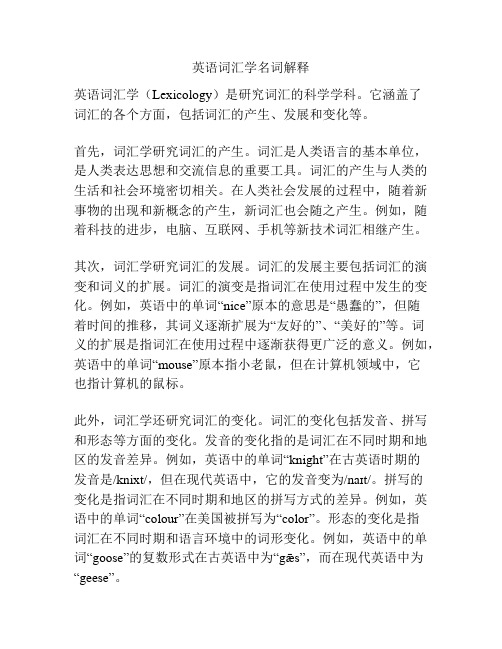
英语词汇学名词解释英语词汇学(Lexicology)是研究词汇的科学学科。
它涵盖了词汇的各个方面,包括词汇的产生、发展和变化等。
首先,词汇学研究词汇的产生。
词汇是人类语言的基本单位,是人类表达思想和交流信息的重要工具。
词汇的产生与人类的生活和社会环境密切相关。
在人类社会发展的过程中,随着新事物的出现和新概念的产生,新词汇也会随之产生。
例如,随着科技的进步,电脑、互联网、手机等新技术词汇相继产生。
其次,词汇学研究词汇的发展。
词汇的发展主要包括词汇的演变和词义的扩展。
词汇的演变是指词汇在使用过程中发生的变化。
例如,英语中的单词“nice”原本的意思是“愚蠢的”,但随着时间的推移,其词义逐渐扩展为“友好的”、“美好的”等。
词义的扩展是指词汇在使用过程中逐渐获得更广泛的意义。
例如,英语中的单词“mouse”原本指小老鼠,但在计算机领域中,它也指计算机的鼠标。
此外,词汇学还研究词汇的变化。
词汇的变化包括发音、拼写和形态等方面的变化。
发音的变化指的是词汇在不同时期和地区的发音差异。
例如,英语中的单词“knight”在古英语时期的发音是/knixt/,但在现代英语中,它的发音变为/naɪt/。
拼写的变化是指词汇在不同时期和地区的拼写方式的差异。
例如,英语中的单词“colour”在美国被拼写为“color”。
形态的变化是指词汇在不同时期和语言环境中的词形变化。
例如,英语中的单词“goose”的复数形式在古英语中为“gǣs”,而在现代英语中为“geese”。
总之,英语词汇学研究词汇的产生、发展和变化,揭示了词汇在语言中的重要地位和作用。
通过深入研究词汇,我们可以更好地理解和运用英语,提高我们的语言能力。
词汇学 名词解释(张韵斐主编版)

名词解释1,word:fundamental units of speech and hacing a mininum, free form.it is a unity of sound and meaning,capable of performing a given syntactical function.2,morpheme:the minimal meaningful unit of the english language,possesses both sound and meaning.the morpheme is not divisible or analyzable into smaller forms.An allomorph(词素变体)is any of the various form of a morpheme.3,freemorpheme:is one that can stand by itself as a complete utterance.4,bound morpheme:cannot exist on its own,mit must appear with at least one other morpheme.5,roots and affixes:a root is the basic unchangeable part of a word,and it conveys the main lexical meaning of the word.Affix is a collective term for the type of formative that can be used only when added to another morpheme.6,inflectional affixes and derivational affixes:An inflectional affix serves to express such meanings as plurality,tense,and the comparative or superlative degree.it does not form a new word with new lexical meaning when it is added to another word. inflectional affixes have only thier particular grammatical meaning.derivational affixes are subdivided into prefixes and suffixes,which are used to related to the formation of new words.7,free root and bound root:Free root can stand alone as woeds and provide the language with a basis for the formation of new words.Bound root cannot appear as woeds in modern English, although they were once words,nor can they be used to form new words.8,hybrid:a hybrid is a word made up of elements from two or more different language.9,compounding/composition:it is a word-formation process consisting of joining two or more bases to form a new unit,a conpound word.10,word-formation rule:the rules of word-formation define the scope and methods whereby speakers of a language may create new words.11,initialisms and acronyms:Initialism is a type of shortening,using the first letters of wors to form a proper name,a technical term , or a phrase.Acronyms are words formed from the initial letters of the name of an organization or a scietific term.12,polysemy:it means a single word having several or many meanings.13,homonyms:homonyms are words different in meaning,but identical both in sound and spelling or identical only in spelling or sound.14,syonyms:words which nearly the same denotative meaning are syonyms,and the relationship between them is one of synonymy.15,antonymy:words that are opposite are antonyms.16,huponymy:it is the relationship which obtains between specific and general lexical item. 17,blending:it is a process of word-formation in which a new word is formed by combining the meanings and sounds of two words , one of which is not in its full form or both of which are notin their full forms.18,back-formation: it is a term used to refer to a type of word-formation by which a shorter word is coined by the deletion of a supposed affix from a longer form already present in the language.19,reduplication:it is a minor type of word-formation by a compound word which is created by the repetition of one word like go-go.20,grammatical meaning and lexical meaning:Grammatical meaning is indispensable in determining the position a word occupies in a sentence.it consists of word-class and inflectional paradigmlexical meaning is that aspect of sense proper to the word as a lexical item.21,semantic field theory:it is concerned with the vocabulary of a language as a system of interrrelated lexical networks.22,linguistic context:three main types of linguistic context are the lexical,grammatical and vorbal context in its broad sense.23,extra-linguistic context/context of situation:(1)the actual speech situation in which a word(or an utterance,or a speech event)occurs.(2)The entire cultural back ground agaicst ehich a word ,or an utterance or a speech eventhas to be set.24,clipping:deletion of one or more syllables from a word (usually a noun),which is also available in its full form.词语辨析1 Plains /pleinz/ a large strentch of flat landPlanes /pleinz/ aeroplane2 row / rəu/ a neat line (of people or things) side by sideRow /rau/ uproar,noisy distuibance3 sound / saund/ n. PronounceSound / saund/ adj. Healthy4 waist /weist/ the narrow part of the human body between the ripes and the hips.Waste /weist/ a useless or profitless spending.Compound words(1) 1 someone who writes songs. Songwriter2 someone who cleans windows. Window-cleaner3 the race for arms. Arms race4 the train in the morning. Morning train5 gold mine6 sunbathing7 dirt cheap8 sun-tanned(2)1 a drop of rain ; the bed for flowers2 impermeable to air ; as green as sew3 a remark that is meant well ; a person that behaves well4 houses ruined by war5 one who designs computer ; one who baths in the sun6 steam powers or operates engine ; an engine prevents fire7 the worm produces silk ; ;the gas produces light8 one who writes by hand ; one who finds fault9 a ship that goes across oceans ; people who love peace10 one who teaches language ; one who sits with the babaies11 boys bred in country1 knee-deep2 lifelike3 snow-white4 nation-wide5 shoulder-high6 pitch-dark/black7 carefree 8 soundproof 9 fireproof 10 lifelong填空Reject 拒绝;退回,摈弃n.不合格产品Refuse 拒绝做某事Decline 谢绝帮助Rapid 瞬间的Fast 快速的Range/fury 狂怒Indignation 义愤近义词反义词Fair-dark empty-full faint-loud low-high gloomy-bright sad-joyful/cheerful dark-bright rough-soft/gentle decline-accept/rise peculiar-common/average light-dark/heavy fresh-stale/faded thin-fat/thick wild-domestic/garden dull-interesting/clever deep-shallow/surface seldom-often hard-easy/soft over-under scarce-plentiful backward-forward总分关系。
词汇学名词解释

词汇学名词解释词汇学是语言学的分支领域之一,研究词汇的性质、结构、意义和使用规律。
以下是对词汇学中几个关键概念的解释:1. 词汇(Lexicon):词汇是一个语言中的全部词条,包括单词、短语和常用搭配等。
词汇是一种基本的语言单位,是语言交流和理解的基础。
2. 词性(Part of Speech):词性指词汇中有关词的分类。
根据词的语法和语义特征,可以将词汇分为名词、动词、形容词、副词、介词、代词、连词和感叹词等不同的词性。
3. 词义(Word Meaning):词义是一个词汇所表达的概念、事物或动作的意义。
词义可以通过定义、同义词、反义词以及词汇搭配等方式进行解释和理解。
4. 词根(Root):词根是一个词汇的基本核心部分,通常带有主要的语义意义。
通过加前缀、后缀和派生等方式,可以将词根组合成更复杂的词汇形式。
5. 同义词(Synonym):同义词是具有相同或相似词义的词汇。
同义词可以提供多种不同的方式来表达同一概念,丰富了语言的表达能力。
6. 反义词(Antonym):反义词是在词义上相互对立或相互排斥的词汇。
通过使用反义词可以传达相反的意义和观点。
7. 语义范畴(Semantic Field):语义范畴是一组具有相似语义关联的词汇。
这些词汇之间存在概念上的联系,并且可以通过它们之间的关系进行划分和归类。
8. 词汇搭配(Collocation):词汇搭配指的是在不同上下文中常常一起出现的词组合。
词汇搭配可以是习语、固定搭配或者常用的短语,对于正确地理解和使用词汇是非常重要的。
9. 词法关系(Lexical Relation):词法关系是不同词汇之间的关系,包括上下义关系、同源关系、形态关系、语法关系等。
这些关系有助于理解词汇之间的联系和共同特征。
10. 词源学(Etymology):词源学研究词汇的起源和历史发展。
通过对词汇的来源和历史变化的研究,可以了解词汇之间的发展和演变过程。
总之,词汇学的研究有助于我们更好地理解和使用词汇,掌握词汇的形式、意义和用法,从而提高语言的表达能力和沟通效果。
英语词汇术语 名词解释

第二部分名词解释1.English lexicologyEnglish Lexicology is a branch of linguistics concerned with the vocabulary of the English language in respect to words and word equivalents。
2.w ordA word may be defined as a fundamental unit of speech and a minimum free form;with a unity of sound and meaning (both lexical and grammatical meaning),capable of performing a given syntactic function。
3.vocabularyAll the words in a language together constitute what is known as its vocabulary.4.native wordsWords of Anglo—Saxon origin or of Old English are called native words.5.loan wordsWords borrowed from other languages are called loan words。
They are also called foreign words and borrowed words.mon wordsCommon words are also called popular words。
They are words connected with the ordinary things or activities necessary to everyday life. Common words are neutral in style。
- 1、下载文档前请自行甄别文档内容的完整性,平台不提供额外的编辑、内容补充、找答案等附加服务。
- 2、"仅部分预览"的文档,不可在线预览部分如存在完整性等问题,可反馈申请退款(可完整预览的文档不适用该条件!)。
- 3、如文档侵犯您的权益,请联系客服反馈,我们会尽快为您处理(人工客服工作时间:9:00-18:30)。
Types of meaningTypes of lexical changes1.Elevation:词义升格Definition: words rise from humble beginnings to positions of importanceSome words early in their history signify something quite low or humble, but change as time goes by to designate something agreeable or pleasant.For example: nice: ignorant---foolish---delightful, pleasantMarshal: a keeper of horses---a high ranking army officerSo elevation refers that the meaning of word changes from the neutral/negative to positive.2.Old English:It refers to the English starting from 450 to 1100 AD. The oldEnglish is made up of different sources of languages spoken then –that of Anglo-Saxons, that of Celts, and that of Jutes, with a lot of Latin elements used for common peopl e’s life.3.Bound morpheme:It is the smallest unit of grammar, a unit which cannot occur as separate words. They have no independent semantic meaning; instead, they have:➢Attached meaning E.g. un-kind, hope-ful➢Grammatical meaning E.g. cat-s, slow-ly, walk-ing, call-edFor an exact example, in the word “careful”, care is free morpheme, “-ful” is a bound morpheme.4.Hyponymy:Hyponymy deals with the relationship of semantic inclusion, or to say, the relationship between general lexical items and specific lexical items. That is to say, when X is a kind of Y, the lower term X is the“hyponym”, and the upper term Y is the “superordinate”. For example, “fiction”is the superordinate of “novel”, “novelette”and “short story”, which are the hyponyms of “fiction”.Knowing the semantic features of the hyponyms and their superordinates can help us achieve vividness, exactness, and concreteness in expression.5.Collocation:Collocation is the habitual juxtaposition of linearly arranged words which occurs multiple times to become set expressions.Collocations have four features:➢They are non-arbitrary and predictable. For example, we can say “have tea” but not “have engine oil”➢They are stable and rigid. Collocations are strong enough to exclude other synonymous words. For example, we can say “strong wind and heavy rain” but not “strong rain and heavy wind”.➢They are culturally-loaded. Collocation reflects the English culture and cultural heritage, such as “the Trojan horse” and “Pandora’s box”.➢They are Language-specific.Collocations can be classified into: (in terms of collocational strength.)weak collocations, (collocations that have a wide variety of collocates. Collocational range is wide.E.g. white/red/green/long/small shirt)strong collocations,(Collocations are strong but not unique.E.g. moved to tears) frozen collocations (Collocations that are fixed and irreplaceable, E.g. foot the bill *foot the coffee)Collocations are non-arbitrary, which means that they are motivated. There are four kinds of motivations:Grammatical motivation, (Collocations serve particular grammatical functions in certain grammatical structures.)Semantic motivation, (The meaning of the collocation depends on the collocated components.)Pragmatic motivation, (Collocations are pragmatically driven and pragmatically shaped. E.g.Buckle up, keep space, )Cognitive motivation. (Metaphorical expression beyond literal interpretation.E.g. red-carpet treatment, political honeymoon, bubble economy, soft landing)Collocation is one important aspect of vocabulary development.It offers the most natural way of language use.It provides alternative ways of language use, which may be more colorful, expressive or precise.It helps to improve the style in writing.6.Morpheme:A morpheme is the smallest meaningful unit of a language. Morpheme can be lexical or grammatical.A free morpheme has complete meaning and can be used as free grammatical units in sentences.A bound morpheme cannot occur as separate words. They are bound to other morphemes to form words.An inflectional morpheme is a morpheme that is used to inflect a word. e.g. white can be inflected with the morphemes -r (whiter) and -est (whitest)A derivational morpheme is a morpheme that is used to create derivations of words. e.g. white can form the derivation whiten by adding the -n morpheme.7.Stylistic meaning:Apart from their conceptual meanings, many words have stylistic features, which make them appropriate for different contexts. These distinctive features form stylistic meaning of words. In some dictionaries ,these stylistic features are clearly marked as “formal”, “informal”, “ literary”, “archaic”, “slang” and so on. This stylistic difference is especially true of synonyms. It is observed that there are few words which have both the same conceptual meaning and the stylistic meaning.8.Analogy:Analogy refers to the process by which words or phrases are created or re-formed according to the existing patterns in the language.E.g. youthquake, airbag, earthriseearthquake, handbag, sunrisepounding:It is a type of word-formation process consisting of joining two or more bases to form a new unit, a compound word. It is also a productive device at every period of the English language. Forms of compounds are solid, hyphenated, open. According to the grammatical property, there are three types of compounds: noun compounds, adjective compounds, verb compounds. For instance, sleeping-bag= sleeping + bag (the bag for sleeping).Today the largest number of new words are formed by compounding.10.Word:A word is defined as a minimum free form of language with a unity of sound and meaning, capable of preforming a given syntactic function. A word contains three elements: form, structural function and meaning. Broadly speaking, all the words in a language together constitute what is known as vocabulary. It is very important to a language.Without words, nothing can be conveyed.11.Superordinate: in the case of hyponymy, superordinate is the upper word standing for thetotality or the group. The word which is more general in meaning is called the superordinate.12.Subordinate: in the case of hyponymy, subordinate is the lower word standing for amember of the group.13.Semantic components: They are the features in a word as far as its concept is concerned.Father –a word with the conceptual features of “adult”, “male”, “humanity”, and “animate”.All the 4 features are its semantic components.14.Derivation:Derivation is the formation of word by adding word-forming or derivational affixes to stems. For example, when the verb “care”add a suffixe “-ful”, a new word ”careful” is formed.This process is also known as affixation. New words formed in this way are called derivatives. According to the position affixes occupy in words, affixation falls into two subcategories: prefixation and suffixation.15.Inflection:The process of changing word form for the sake of grammaticality, withoutchanging its meaning.16.Back formation:Backformation is a process of word-formation by which a word is created by the deletion of a supposed suffix from a longer form already present in the language. It is also called reverse derivation. The process of word-formation by changing from one form into another for m, as in “edit” from “editor”(initial word).17.Connotative meaning:For people with different cultural backgrounds, a word might evoke different associations.It is the extended meaning of a word. When a word is enlarged in meaning, its meaning is no longe r limited to the original sense. For instance, “torch” in certain context indicates the hope or the ambition/spirit based on its original sense.The connotative meaning of a word refers to the feeling that a word invokes. This differs from its dictionary definition, which is called its "denotative" meaning. Two words can have similar denotations but very different connotations. For example, the words "miserly" and "thrifty" are both adjectives that describe a person who goes to certain lengths to save money. However, "miserly" has strong negative connotations, while "thrifty" evokes positive feelings in a reader.18.Affective meaning:the meaning of a word as decided by the person who uses it withhis/her personal emotion. Positive or negative sense belongs to affective meaning.It refers to the speaker’s attitude towards the person or thing in question. You may address sb as an “idiot” to convey your despise, or describe sth as “marvelous”to express your positive evalution. This meaning can be conveyed into three types by the choice of words: commendatory, derogatory and neutral.Extension:It is a process by which a word which originally had a specialized meaning has now become generalized, or has extended to cover a broader and often less definite concept.For example, the original meaning of manuscript is the handwriting( writing by hand only), but nowadays, it refers to any author’s writing whether written by hand or typed with a type-writer or a word-processorA large proportion of polysemic words of modern English have their meanings extended in the course of development.19.Degradation:It is a process whereby words of good origin or affective neutrality fall into ill reputation or come to be used in a derogatory sense. It is the reverse of elevation.For example, “sad” formerly refers to full, satisfied, but now comes to be described “sorrowful”.20.Specialization: the meaning is limited and reduced to certain sense. It is also called“narrowing”.。
